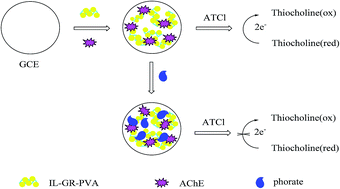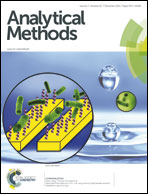Development of a sensitive acetylcholinesterase biosensor based on a functionalized graphene–polyvinyl alcohol nanocomposite for organophosphorous pesticide detection
Abstract
A highly sensitive and stable acetylcholinesterase (AChE) biosensor was successfully developed based on ionic liquid functionalized graphene (IL-GR) and polyvinyl alcohol (PVA) to detect organophosphorous pesticides (OPs). IL-GR was firstly synthesized through the epoxide ring-opening reaction between 1-aminoethyl-2,3-dimethylimidazolium bromide (IL) and graphite oxide, and then was homogeneously dispersed in PVA to form an IL-GR–PVA nanocomposite in order to modify a glassy carbon electrode (GCE) for AChE immobilization. The IL-GR–PVA nanocomposite with excellent conductivity and biocompatibility offered an extremely hydrophilic surface for AChE adhesion. It effectively promoted the electron transfer rate of the electrode interface and facilitated the access of substrates to the active centers. Using phorate as a model compound, the conditions for OP detection were optimized. Under optimum conditions, a linear relationship between the inhibition percentage (I%) and logarithm of concentration of phorate was found in the range from 1.0 × 10−14 to 1.0 × 10−9 M and from 1.0 × 10−9 to 1.0 × 10−6 M, with a detection limit of 8.0 × 10−15 M (S/N = 3). The easily prepared electrochemical sensor had favorable stability and sensitivity, thus providing a new pesticide detection method.


 Please wait while we load your content...
Please wait while we load your content...